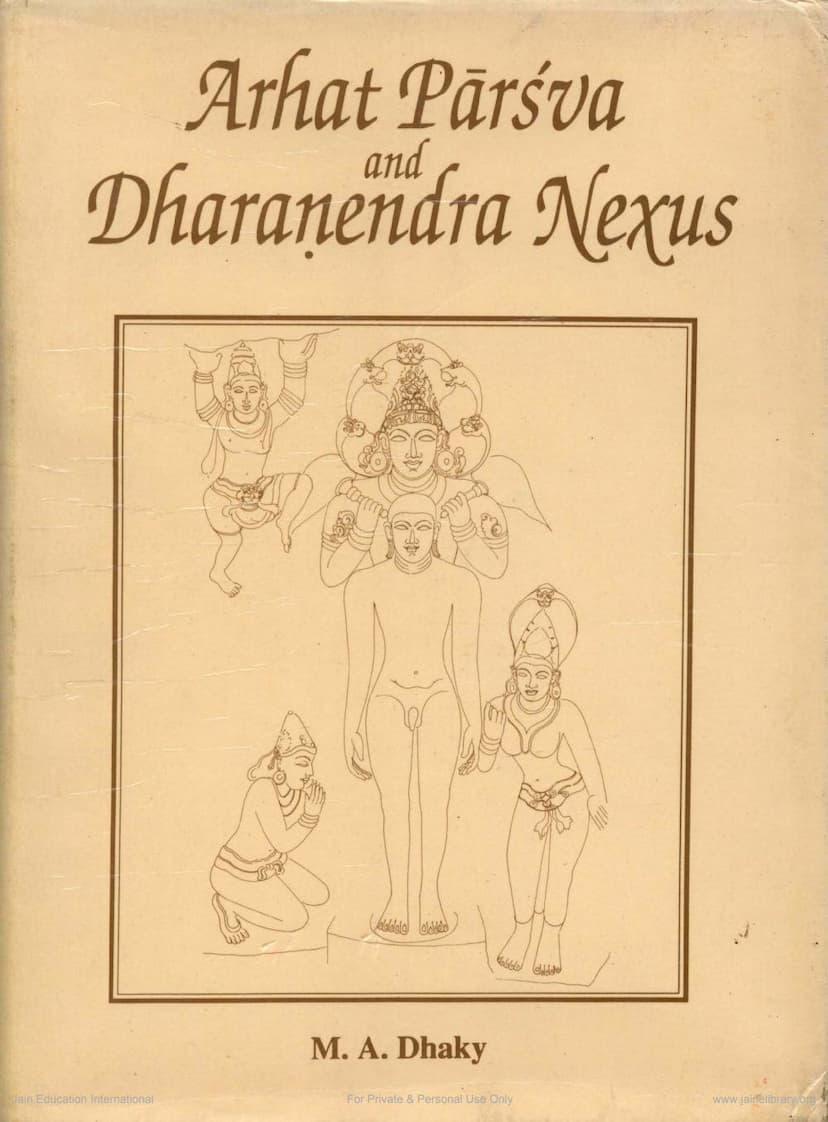Arhat Parshva And Dharnendra Nexus
Added to library: September 1, 2025

Summary
Here's a comprehensive summary of the Jain text "Arhat Parshva and Dharnendra Nexus" by M.A. Dhaky, based on the provided pages:
Book Title: Arhat Parshva and Dharnendra Nexus Editor: M.A. Dhaky Publisher: L.D. Indology, Ahmedabad & Bhogilal Leherchand Institute of Indology, Delhi Publication Year: 1997
Overview: This volume compiles papers presented at a seminar organized by the B.L. Institute of Indology on the theme of "Arhat Pārśva and Dharanendra Nexus." The collection aims to illuminate various aspects of Arhat Pārśva, including his history, teachings, doctrines, monastic discipline, and his significant association with the Nāgarāja Dharanendra. It draws upon both textual and epigraphical evidence, as well as art historical analysis, to provide a multi-faceted understanding of this important figure in Jainism.
Key Themes and Content:
-
Historical Context of Arhat Pārśva:
- The papers establish the historicity of Arhat Pārśva, generally considered the 23rd Tīrthaṅkara, often distinguishing his teachings and monastic discipline from those of Jina Mahāvīra.
- Early Jain canonical literature, particularly the Śvetāmbara canon, provides much of the available information. However, the original texts of Pārśva's sect are largely lost.
- Discussions touch upon the period in which Pārśva flourished, with some scholars suggesting a dating that challenges the traditional 250-year gap between him and Mahāvīra, based on the interaction between Pārśva's followers and Mahāvīra's immediate disciples.
- Pārśva's teachings, as gleaned from texts like the Isibhāṣiyāiñ (Rṣibhāṣitāni), emphasize a five-element cosmology (pañcāstikāya), eight types of karma (karma), the concept of transmigration (gati), and the world's eternal and dynamic nature. His doctrine of caturyāma-dharma (fourfold vows) is contrasted with Mahāvīra's pañca-mahāvrata (fivefold great vows), with Mahāvīra adding celibacy as a distinct vow.
-
The Dharanendra Nexus:
- A central focus of the volume is the unique association of Arhat Pārśva with the Nāgarāja Dharanendra, visually represented by the serpent canopy over Pārśva's head. This association is a distinguishing feature of Pārśva's iconography.
- The upasarga (hardship or torment) episode, where the demon Kamatha (in a previous life) attempts to disturb Pārśva's meditation, leading to Dharanendra's intervention, is explored in detail. This myth, though not found in the earliest āgamas, is prevalent in later narrative literature and sculptural representations from around the 6th century AD onwards.
- The papers discuss various interpretations of this nexus, including possible totemic symbols, ancestral links to Nāga tribes, and shared cultural milieu with Buddhist traditions (like the Mucalinda story).
- The iconography of Pārśva with Dharanendra is traced through various regional art styles in India, from early Gupta/post-Gupta periods through the medieval era, with significant coverage of Central India, Uttar Pradesh, Rajasthan, Gujarat, Orissa, Bengal, and South India.
-
Art Historical and Iconographic Studies:
- Several papers meticulously analyze Pārśvanātha images and temples across different regions of India.
- Central India (Madhya Pradesh, Bundelkhand): Focuses on images from the Gupta, post-Gupta, Pratihāra, Cedi, Candella, Kacchapaghāta, and Paramāra periods (c. 4th to 13th centuries AD). Early images often follow classical Mathura traditions, showing Pārśva seated or standing, with a seven-hooded serpent canopy, flanked by Dharanendra and Padmavati. Later periods show increasing regional variations.
- Uttar Pradesh: Highlights early evidence from Mathura, including āyāgapaṭṭas and sculptures from the Kushāṇa period, indicating Pārśva's veneration. Various seated and standing images, sarvatobhadrikā forms, and depictions with the upasarga theme are discussed.
- Rajasthan: Details the numerous atiśaya (miraculous) tīrthas dedicated to Pārśva, emphasizing their importance due to the perceived miraculous powers of the images, rather than the occurrence of kalyāṇakas (auspicious life events). Sites like Karheḍā, Kāparḍā, Jīrāvalā, Nākorā, and Phalavardhi are discussed.
- Gujarat: Examines the development of Pārśva tīrthas from the medieval period onwards, with Stambhana, Sankhapura (Sankheśvara), and Anahillapāṭaka (Pañcāsara) being prominent. Early agamic literature did not mention Pārśva tīrthas in Gujarat.
- Orissa and Bengal: Discusses the presence of Pārśva images and temples, noting the consistent iconographic formula used across various sites, although precise chronological dating based solely on iconography is challenging. The association with Dharanendra and Padmavati is common.
- South India (Karnataka, Andhra Pradesh, Kerala, Tamil Nadu): While epigraphical references in Andhra Pradesh and Kerala are scarce, Tamil Nadu and Karnataka show more significant evidence. In Karnataka, Pārśva's popularity is evident from early Kadamba records through the Hoysala period, with detailed analyses of Pārśva images and their iconographic features, including the upasarga theme, in sites like Bādāmī, Aihole, Humca, and Śravaṇa Belgola.
-
Hymnic Literature:
- The volume also analyzes early and medieval Jain hymns and stavanas dedicated to Pārśva, tracing the emergence of references to the Dharanendra nexus in compositions from the 5th century AD onwards, particularly in Prakrit and Sanskrit literature.
- Early hymns (like Caturvimśati-stava) do not mention Dharanendra, but later compositions, especially from the medieval period in Western India (Śvetāmbara tradition), frequently depict Pārśva canopied by Dharanendra, often in tantric contexts.
Overall Contribution: The collection provides a valuable scholarly resource for understanding the historical, doctrinal, and artistic significance of Arhat Pārśva and his unique relationship with Nāgarāja Dharanendra. It highlights the evolution of Pārśva's iconography and the development of his worship across different regions and periods of Indian history, based on extensive review of primary sources and archaeological findings. The book serves as a foundational work for further research into this specific aspect of Jainism.